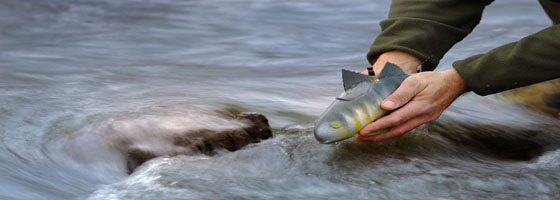Back to school: Robotic fish make a splash

During the 2010 Gulf oil spill, machines were used under water to cut pipes and prepare them for repairs that would eventually stem the flow of oil. Robots succeeded where it was too difficult or dangerous for human workers to go. Innovative research aims to extend robot aid to another area where humans aren’t well-suited to be – swimming with the fishes.
Alongside a team of researchers and students, Dr. Xiaobo Tan, an associate professor in the Department of Electrical and Computer Engineering at Michigan State University, is developing robotic fish that will eventually monitor water quality in real-time. Tan’s research could be the next step in preventing, monitoring and/or restoring issues such as algal blooms, toxic contaminants and oil spills. Fish and other aquatic species have long been indicators of the health of a waterway at large. They accumulate contaminants through both the food chain and aquatic environment. They’re also mobile, and can give insight into the extent of a spill and how wide-ranging its effects might be.
Tan hopes that the robotic fish will “dynamically and adaptively collect information as a mobile wireless network in water.” Field tests are planned for the summer of 2012, and the team is hopeful for eventual deployment and industry-wide use.
Currently on Generation III of the robots, the team is working to optimize the fish mechanism, shape, and material to achieve the best performance.
“For environment-monitoring robotic fish, we are not modeling after specific species. Instead, we take a general fish shape that would house all electronics and other components with minimal volume; We then try to fine-tune the body/tail shape to optimize speed etc., using both simulation and experimentation,” Tan said. With each revision, the team works toward a more energy-efficient, agile, and quick-moving robotic fish.
The initiative began as a student project for an educational outreach program. Shortly after arriving at MSU seven years ago, Tan taught a class in which one of the College of Engineering staff members, Drew Kim, enrolled. For the class project , Tan and Kim decided to develop an interesting robot to be used for community involvement and education to excite K-12 students about science and engineering.
A tadpole with an artificial muscle tail was the first prototype developed. Tan describes the initial version as “an Easter egg with a wiggling tail… at that time, we were not thinking seriously about water quality yet.”
After recognizing the project’s potential, Tan set to work on creating the next version.
To build the fish, advanced fabrication techniques such as 3D printing are used to create and assemble the parts. GPS units, 3D compasses and water quality monitoring sensors are installed on the robo-fish. This is a lot of equipment for such a small prototype, as surface-swimmers are between 20-30 cm in length; diving fish, currently under development, may reach 50-60 cm in length.
Using mathematical models and control theory, the team is developing prototypes that will be able to mimic the movements of a network, or school of fish. Eventually, the robo-fish should be able to sense the distance, movement, and wakes of surrounding robotic fish and make a decision about which direction to swim.
As successful as the project has been so far, Tan and his team are now running up against a considerable hurdle: the size and cost of current sensors.
“If I look at the cost, I have a robotic fish that may cost a couple thousand dollars, and a single water-quality sensor may cost more than that,” Tan said. “The sensors are also very large – no serious and sufficient effort has been put into miniaturizing these sensors, making them smaller, and cheaper.”
Such sensors would allow Tan and his team to create and research many more robotic fish, eventually making the robotic fish themselves cheaper and more easily accessible, he said.
Tan compares the dilemma to what came first, the chicken, or the egg? His hope is that manufacturers in the industry will notice the trend of smaller robotic devices: researchers and professionals are looking for smaller, cheaper, more cost effective sensors that facilitate wider use of monitoring technology. Regardless, Tan’s team will continue to move forward. “Until then, we will continue to buy whatever is available,” Tan said.





0 comments